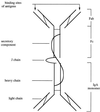Oral microbial ecology and the role of salivary immunoglobulin A
- PMID: 9529888
- PMCID: PMC98907
- DOI: 10.1128/MMBR.62.1.71-109.1998
Oral microbial ecology and the role of salivary immunoglobulin A
Abstract
In the oral cavity, indigenous bacteria are often associated with two major oral diseases, caries and periodontal diseases. These diseases seem to appear following an imbalance in the oral resident microbiota, leading to the emergence of potentially pathogenic bacteria. To define the process involved in caries and periodontal diseases, it is necessary to understand the ecology of the oral cavity and to identify the factors responsible for the transition of the oral microbiota from a commensal to a pathogenic relationship with the host. The regulatory forces influencing the oral ecosystem can be divided into three major categories: host related, microbe related, and external factors. Among host factors, secretory immunoglobulin A (SIgA) constitutes the main specific immune defense mechanism in saliva and may play an important role in the homeostasis of the oral microbiota. Naturally occurring SIgA antibodies that are reactive against a variety of indigenous bacteria are detectable in saliva. These antibodies may control the oral microbiota by reducing the adherence of bacteria to the oral mucosa and teeth. It is thought that protection against bacterial etiologic agents of caries and periodontal diseases could be conferred by the induction of SIgA antibodies via the stimulation of the mucosal immune system. However, elucidation of the role of the SIgA immune system in controlling the oral indigenous microbiota is a prerequisite for the development of effective vaccines against these diseases. The role of SIgA antibodies in the acquisition and the regulation of the indigenous microbiota is still controversial. Our review discusses the importance of SIgA among the multiple factors that control the oral microbiota. It describes the oral ecosystems, the principal factors that may control the oral microbiota, a basic knowledge of the secretory immune system, the biological functions of SIgA, and, finally, experiments related to the role of SIgA in oral microbial ecology.
Figures

Similar articles
-
Host Immune Selection of Rumen Bacteria through Salivary Secretory IgA.Front Microbiol. 2017 May 12;8:848. doi: 10.3389/fmicb.2017.00848. eCollection 2017. Front Microbiol. 2017. PMID: 28553275 Free PMC article.
-
Humoral immunity to commensal oral bacteria in human infants: salivary secretory immunoglobulin A antibodies reactive with Streptococcus mitis biovar 1, Streptococcus oralis, Streptococcus mutans, and Enterococcus faecalis during the first two years of life.Infect Immun. 1999 Apr;67(4):1878-86. doi: 10.1128/IAI.67.4.1878-1886.1999. Infect Immun. 1999. PMID: 10085031 Free PMC article.
-
No apparent influence of immunoglobulins on indigenous oral and intestinal microbiota of mice.Infect Immun. 1996 Nov;64(11):4694-9. doi: 10.1128/iai.64.11.4694-4699.1996. Infect Immun. 1996. PMID: 8890227 Free PMC article.
-
Opportunistic respiratory pathogens in the oral cavity of the elderly.FEMS Immunol Med Microbiol. 2010 Oct;60(1):1-17. doi: 10.1111/j.1574-695X.2010.00709.x. FEMS Immunol Med Microbiol. 2010. PMID: 20579096 Review.
-
Human oral microbial ecology and dental caries and periodontal diseases.Crit Rev Oral Biol Med. 1996;7(2):180-98. doi: 10.1177/10454411960070020601. Crit Rev Oral Biol Med. 1996. PMID: 8875032 Review.
Cited by
-
Physical seed damage, not rodent's saliva, accelerates seed germination of trees in a subtropical forest.Ecol Evol. 2024 Jul 17;14(7):e11500. doi: 10.1002/ece3.11500. eCollection 2024 Jul. Ecol Evol. 2024. PMID: 39026954 Free PMC article.
-
Local and Systemic Effects of Porphyromonas gingivalis Infection.Microorganisms. 2023 Feb 13;11(2):470. doi: 10.3390/microorganisms11020470. Microorganisms. 2023. PMID: 36838435 Free PMC article. Review.
-
Changes in Salivary Parameters of Oral Immunity after Biologic Therapy for Inflammatory Bowel Disease.Life (Basel). 2021 Dec 16;11(12):1409. doi: 10.3390/life11121409. Life (Basel). 2021. PMID: 34947940 Free PMC article.
-
Green synthesis of silver oxide nanoparticles and its antibacterial activity against dental pathogens.3 Biotech. 2017 May;7(1):72. doi: 10.1007/s13205-017-0670-4. Epub 2017 Apr 27. 3 Biotech. 2017. PMID: 28452017 Free PMC article.
-
Experimental Murine Periodontitis Increases Salivary Gland IgA-Producing B Cells Following Oral Dysbiosis.Microbiol Immunol. 2025 Feb;69(2):114-127. doi: 10.1111/1348-0421.13191. Epub 2024 Dec 22. Microbiol Immunol. 2025. PMID: 39709535 Free PMC article.
References
-
- Aaltonen A S, Tenovuo J, Lehtonen O-P, Saksala R. Maternal caries incidence and salivary close-contacts with children affect antibody levels to Streptococcus mutans in children. Oral Microbiol Immunol. 1990;5:12–18. - PubMed
-
- Aaltonen A S, Tenovuo J, Lehtonen O-P. Increased dental caries activity in pre-school children with low baseline levels of serum IgG antibodies against the bacterial species Streptococcus mutans. Arch Oral Biol. 1987;32:55–60. - PubMed
-
- Abu-Ghazaleh R I, Fujisawa T, Mestecky J, Kyle R A, Gleich G J. IgA induced eosinophil degranulation. J Immunol. 1989;142:2393–2400. - PubMed
-
- Adachi M, Yodoi J, Noro N, Masuda T, Uchino H. Murine IgA binding factors produced by FcαR(+) T cells: role of FcγR(+) cells for the induction of FcαR and formation of IgA-binding factor in Con A-activated cells. J Immunol. 1984;133:65–71. - PubMed
-
- Aguirre A, Testa-Weintraub L A, Banderas J A, Haraszthy G G, Reddy M S, Levine M J. Sialochemistry: a diagnostic tool. Crit Rev Oral Biol Med. 1993;4:343–350. - PubMed
Publication types
MeSH terms
Substances
LinkOut - more resources
Full Text Sources
Other Literature Sources

